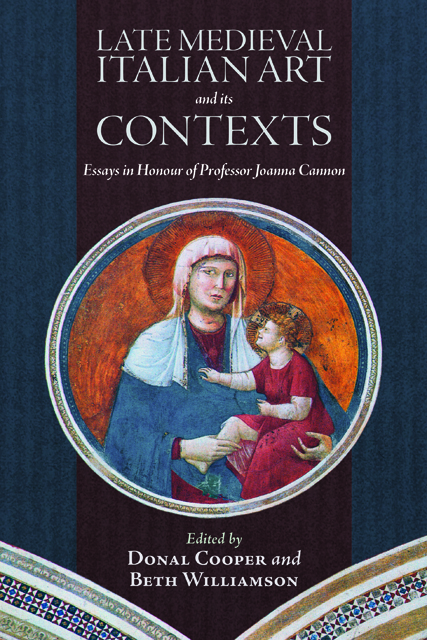Book contents
- Frontmatter
- Contents
- List of Illustrations
- List of Contributors
- Acknowledgements
- List of Abbreviations
- 1 Introduction: Circling Giotto
- 2 Holy Wood / ‘sacra tavola’: Saint Dominic and the Memory of Miracles in Bologna
- 3 The Sculpted Saint: A Statue of Saint Francis in Siena
- 4 Guccio di Mannaia and the Concept of a ‘Franciscan’ Chalice
- 5 ‘Speculum sine macula’: The Trittico di Santa Chiara in Trieste as an Object of Clarissan Devotion
- 6 The Siena Connection: A Franciscan Provincial Minister between Tuscany and Assisi at the Dawn of the Trecento
- 7 Simone Martini’s ‘Treaty with the House of Santa Fiora’ in Siena’s Palazzo Pubblico: Its Date and Significance
- 8 Crisis and Charity in Fourteenth-Century Florence: Ambrogio Lorenzetti’s Saint Nicholas Panels for San Procolo
- 9 Father of Light: Giotto and the Beatific Vision in the Baroncelli Chapel
- 10 Painter-Illuminator Workshops and the Church of San Giorgio a Ruballa: The Case of Bernardo Daddi and Pacino di Bonaguida
- 11 Patterns of Holiness: A Virgin Lactans in a Franciscan Context
- 12 A New Angle on Simone Martini’s Holy Family
- 13 Artistic Appropriation, Institutional Identity, and Civic Religion in Fourteenth-Century Siena: The Byzantine Treasury of the Hospital of Santa Maria della Scala
- 14 Visual Religious Education in Late Medieval Florence: Zanobi Perini, The Leggenda di Santo Tobia, and The Misericordia
- 15 Saints and Status in Late Medieval and Early Renaissance Florence
- Select Bibliography
- Publications by Joanna Cannon
- Index
- Tabula Gratulatoria
- Backmatter
9 - Father of Light: Giotto and the Beatific Vision in the Baroncelli Chapel
Published online by Cambridge University Press: 20 December 2022
- Frontmatter
- Contents
- List of Illustrations
- List of Contributors
- Acknowledgements
- List of Abbreviations
- 1 Introduction: Circling Giotto
- 2 Holy Wood / ‘sacra tavola’: Saint Dominic and the Memory of Miracles in Bologna
- 3 The Sculpted Saint: A Statue of Saint Francis in Siena
- 4 Guccio di Mannaia and the Concept of a ‘Franciscan’ Chalice
- 5 ‘Speculum sine macula’: The Trittico di Santa Chiara in Trieste as an Object of Clarissan Devotion
- 6 The Siena Connection: A Franciscan Provincial Minister between Tuscany and Assisi at the Dawn of the Trecento
- 7 Simone Martini’s ‘Treaty with the House of Santa Fiora’ in Siena’s Palazzo Pubblico: Its Date and Significance
- 8 Crisis and Charity in Fourteenth-Century Florence: Ambrogio Lorenzetti’s Saint Nicholas Panels for San Procolo
- 9 Father of Light: Giotto and the Beatific Vision in the Baroncelli Chapel
- 10 Painter-Illuminator Workshops and the Church of San Giorgio a Ruballa: The Case of Bernardo Daddi and Pacino di Bonaguida
- 11 Patterns of Holiness: A Virgin Lactans in a Franciscan Context
- 12 A New Angle on Simone Martini’s Holy Family
- 13 Artistic Appropriation, Institutional Identity, and Civic Religion in Fourteenth-Century Siena: The Byzantine Treasury of the Hospital of Santa Maria della Scala
- 14 Visual Religious Education in Late Medieval Florence: Zanobi Perini, The Leggenda di Santo Tobia, and The Misericordia
- 15 Saints and Status in Late Medieval and Early Renaissance Florence
- Select Bibliography
- Publications by Joanna Cannon
- Index
- Tabula Gratulatoria
- Backmatter
Summary
The decorative scheme of the Baroncelli chapel in the church of Santa Croce in Florence (Fig. 9.1) – including frescoes on the walls depicting the life of the Virgin, frescoes in the vault with allegorical representations of the virtues, stained glass with images of saints, sculpture at the entrance to the chapel, and Giotto’s altarpiece of the Coronation of the Virgin (Plate XII) – can be said to have at least two registers of meaning. On one level, the iconographical programme reflects the Baroncelli family’s concerns with salvation. Overlaying this relatively straightforward reading, however, is a more complex Franciscan theology that weaves together divine revelation, angelic visitation, and light in reference to salvation. The purpose of this chapter is to revisit these layers of meaning, and to suggest more specifically that the chapel’s iconographic scheme reflects Franciscan views on the Beatific Vision controversy, which reached its peak between 1331 and 1336, with implications for both our reading of the chapel’s imagery and the dating of its decoration.
The controversy was the most prominent theological dispute of the time and centred on whether the saved attained the Beatific Vision – the full and unmediated vision of God in heaven – immediately after death, or whether this would only occur after the resurrection of the body at the Last Judgement. In a series of sermons delivered in 1331–32, Pope John XXII (Jacques Duese, r. 1316–34) proposed that souls could not enjoy the sight of God until Judgement Day. These views met with great resistance among Dominican thinkers and also Spiritual Franciscans, who were already at odds with the Pope over the Poverty Controversy. Other Franciscans, however, agreed with John, or at least took a more nuanced view of the afterlife in which the Beatific Vision was gradually attained and perfected. The iconography of the Baroncelli chapel – which insists on the importance of the resurrected body – reflects the Franciscan idea of the gradual attainment of perfect vision, and of the body perfecting the vision of God, ideas moreover aligned with Bonaventure’s writings about spiritual seeing and the ascent of the soul to God beginning during life.
- Type
- Chapter
- Information
- Late Medieval Italian Art and its ContextsEssays in Honour of Professor Joanna Cannon, pp. 159 - 180Publisher: Boydell & BrewerPrint publication year: 2022



